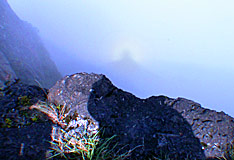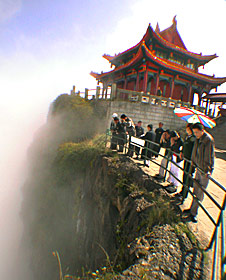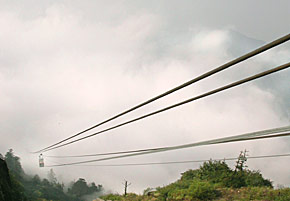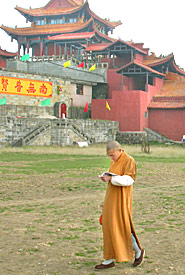Getting to the Top
In China, they say you haven't lived a full life until you've scaled the four sacred mountains. But on a trek to the top of Mt. Emei, highest of them all, one quickly finds that reaching the summit isn't what life's great climb is all about.
By Ron Gluckman /Atop Mt. Emei, in Sichuan Province
AS SUNLIGHT FILTERS THROUGH THE SWIRLING MIST at the summit of Mount Emei, down the steep slopes, amongst the shifting shapes of ridges and clouds, the fabled glow of Buddha's Halo suddenly takes magical form.
 Like an eerie phantasm, the ancient figure
appears upon a curtain of clouds as if projected upon a movie screen. Even more
startling, this vision is shrouded in the stunning aura of a colorful rainbow.
Like an eerie phantasm, the ancient figure
appears upon a curtain of clouds as if projected upon a movie screen. Even more
startling, this vision is shrouded in the stunning aura of a colorful rainbow.
Suspiciously, I spin around to see if others atop this sacred mountain share this positively hallucinogenic view. Surprisingly, none do - at least not exactly as I do. The amazing halo seems to shine for my eyes only. Even more enchantingly, when I wave, the Buddha waves back.
Then, I notice everybody else is waving, too, as if to secret friends only they see. Suddenly, the mystery becomes clear. No mystical aberration floats upon the clouds, only my own silhouette, reflected in Technicolor trim.
The magical phenomena is a quirk that occurs with the right mixture of sunlight and mist. Still, seeing this rare sight clearly qualifies as among the most mesmerizing of the Ten Wonders of Mount Emei.
 Presumptuous? Perhaps. Few spots on Earth
warrant such billing, yet this mountain, among the holiest in China, does
measure up with a world of wonders scattered up and down its slopes.
Presumptuous? Perhaps. Few spots on Earth
warrant such billing, yet this mountain, among the holiest in China, does
measure up with a world of wonders scattered up and down its slopes.
Besides Buddha's Halo, several of the other wonders can be viewed at the peak, including the arresting Sea of Clouds and Golden Sunrise, when the very heavens seem to be flaming with an eruption of lava-like early-morning light.
Hence, despite the climb, this 3,100-meter summit has drawn pilgrims for thousands of years. One old Chinese saying maintains that life hasn't been lived until the Middle Kingdom's four sacred mountains have been scaled.
Another claims, "No place under heaven is as beautiful as Mount Emei." This implies a bit of high-altitude one-upmanship, since Emei soars 1,000 meters or more above the rest of the holy mountains.
So, it's no surprise to find James Qiu soaking his soul in soaring views at the summit. Countless countrymen have scaled this mountain, yet few have labored as long on such a twisted path to the top as Qiu.
Born 42 years ago in nearby Chengdu, he first plotted the climb as a final high school fling with some friends from his graduating class. An unexpected injury forced Qiu from that expedition. Then came university, and advanced education in the United States, where he has lived ever since.
 Scaling Emei has been an itch Qiu has waited
a quarter-century to satisfy. That makes the summit view all the more pleasing,
and personal. "This is something I've longed to see my whole life," he
says, puffing with pleasure in the thin air.
Scaling Emei has been an itch Qiu has waited
a quarter-century to satisfy. That makes the summit view all the more pleasing,
and personal. "This is something I've longed to see my whole life," he
says, puffing with pleasure in the thin air.
Nor has it been easily attained. Qiu left Chengdu before dawn, then spent a full day climbing, eschewing cable cars and buses. "I wanted to use my own legs," he says.
Darkness fell before he reached the top. Hence, his first clear sight of Golden Temple, perched on the peak, waits until morning. Qiu rises before dawn to savor the Golden Sunrise. But not for long.
After nearly 10 hours up Emei yesterday, he turns around and promptly speeds back down. "I'm in a bit of hurry," he explains, sheepishly.
An overnight hump up and down Mount Emei might seem something of sacrilege, especially since so many monks spent their entire lives on this sacred mountain.
Of course, others do Emei even more quickly, thanks to cable cars and mini-buses that have made the ancient site of pilgrimage accessible to mass tourists. Nowadays, most opt for tours from Chengdu, about three hours to the mountain base, then another two hours to Jieyin Dien, where you already feel the air at 2,540 meters.
 A Swiss-style cable car soars over pines to
Jih Ding, and a final hike of about an hour, huffing and puffing in the high
altitude, to the peak. Some don't even bother to spend the night for the
sunrise, completing the mountain tour in a single frantic day.
A Swiss-style cable car soars over pines to
Jih Ding, and a final hike of about an hour, huffing and puffing in the high
altitude, to the peak. Some don't even bother to spend the night for the
sunrise, completing the mountain tour in a single frantic day.
They leave Chengdu in the dark, make a quick circuit of the mountain and return via Leshan, for a fast peek at the world's largest Buddha statue, an hour by road from Emei's base.
This is a shortsighted way to see an UNESCO world heritage site with so many unique attractions. These include an astounding diversity of temple architecture in an region renowned as the cradle of Buddhist civilization in early China.
The largest surviving site is Baoguo Monastery, at the mountain base. Built in the 16th Century, this is the usual starting point for any serious exploration. The monastery includes a library of sutras and a huge porcelain Buddha.
Further up the mountain lies the Monastery of the Lurking Tiger (fuhu si), which features a lovely seven-meter high copper pagoda.
Visiting all the temples and shrines would
take weeks. But you hardly need to be a fan of religious sites to be smitten by
Emei. Indeed, the mountain abounds in a variety of riches guaranteed to wow
practically any visitor, for as long as one's itinerary allows.
Nature lovers are particularly pleased; among thousands of bird species, the mountain is home to scores endemic to Emei. The wildlife is nearly as prolific.
Unfortunately, the varieties you're most likely to encounter are naughty, monkeys that have clearly had too much contact with visitors; they beg for food and grab your bags as you pass on the mountain trails. Many Emei visitors carry a cane to shoo them away.
Far more pleasing on any walk is the scenery: spectacular forests, flowers and waterfalls. With four climatic zones from sub-tropical at the base, to sub-alpine at the summit, Emei sports a wonderland of fauna, including the most dynamic range of pine trees you will find in China. Some strands of trees are over 1,000 years old.
Like any great hiking grounds, the routes around Mount Emei are remarkably varied, so no two trips are likely to be the same.
Advance planning pays dividends, though, as anyone who has started in shorts and T-shirt at Emei town, at the base, only to spend the night shivering in blankets at the summit, can attest. Temperature swings can be astounding; twenty degree variations from top to bottom are regularly recorded.
 There are several comfortable lodges at the
summit, where the views are staggering, even on overcast days. The favored
lookouts are the sheer ledges below Golden Top Temple.
There are several comfortable lodges at the
summit, where the views are staggering, even on overcast days. The favored
lookouts are the sheer ledges below Golden Top Temple.
The name refers to the old bronze-coated roof, rather than the current orange-tiled one. Still, perched on the peak, the temple is inspiring. One can sit in rapture all day watching cascades of clouds crash into the cliffs, swallowing mountains that drift in and out of sunny views like waves in a surreal sea.
Heading back down, Emei offers one mesmerizing view after another. There are tacky attractions, too, from the constant chatter of annoying shills at the medicine stalls to the overbuilt landing areas, with the usual assortment of commercial diversions and trinket stands.
Still, sidestepping the manmade attractions is easy enough. Nothing added in the last couple thousand years can detract from a mountain that took millions of years to craft. Skipping down from the summit, I'm euphoric. Still seven more wonders to see!
Ron Gluckman is an American reporter who has spent over a dozen years in Greater China, roaming the region for a wide variety of publications. This piece appeared in the December 2002 issue of Silk Road, the magazine of Hong Kong-based Dragon Airlines.
To return to the opening page and index
push here
[right.htm]
